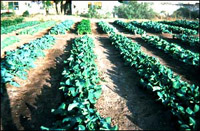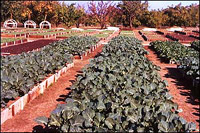about
shop 
freebies
What is the Mittleider Method?
To help you get a better understanding of what exactly the Mittleider Method is all about, we have taken the introduction of the complete Mittleider Gardening Course book and published it right here for you to peruse. We hope you’ll take a bit of time to learn about the different gardening techniques presented here and learn for yourself how to successfully use the Mittleider Method.
Use the following links to jump to any question on the page:
What is the Mittleider Method?
Who developed the Mittleider Method?
Is the Mittleider Method for me?
What is the Mittleider Method?
The Mittleider Method combines the best features of soil-based gardening and hydroponic gardening, but without hydroponic expense! It’s a complete, easy-to-follow plan that eliminates guesswork and ensures success anywhere: an apartment patio, a city yard, a country lot, or a farm.
The method is based on maximum utilization of space, time, and resources. Crops are large because plants are close together, nourished by supplemental feedings of natural mineral nutrients (as in hydroponics), but with no special equipment.
Also, unlike hydroponics, the Mittleider Method gives plants access to the natural soil for nutrients as yet unknown or that, while not essential to plant growth, are useful in human nutrition. You can use the Mittleider Method by raising crops in either soil-beds or grow-boxes and you’ll enjoy amazing yields like never before!
Who developed this method?
Dr. Jacob R. Mittleider, world-renowned international agricultural consultant, developed this method of gardening while conducting family garden-size agricultural training and program development in 27 different countries. The Mittleider Method is based on 55 years of study and gardening experience.
After 20 years of growing flowers and vegetables commercially, Dr. Mittleider embarked on a program of sharing his expertise with gardeners and would-be gardeners around the world. In 1964 he was asked by Loma Linda University in California to take an extended trip to study the diets of the people in developing countries. He traveled through the Middle East, Africa, India, Australia, Southeast Asia, and the South Pacific.
He found that the diseases, insects, and nutritional deficiencies were similar in all countries visited and that the agricultural problems closely resembled those in the United States. He concluded that the solution to their food problems simply required carrying out the recommendations of experts in plant nutrition and following scientific agricultural practices.
Thus he developed the Mittleider Method of gardening—an easy-to-use method that allows gardeners to raise an abundance of vegetables and other crops on almost any soil, in practically any season, in almost any climate, and virtually at any elevation.
You can read even more about him right here.
How is the Mittleider Method different?
| Traditional Method | Mittleider Method | |
|---|---|---|
| Overall: | High yields are hard to get. Each of the gardening tasks require so much skill and understanding that few beginners can raise a productive garden. | With proper know-how even beginners can raise highly-productive gardens. |
| The Gardener: | To grow a garden, the gardener must have skill, experience, good soil, the cooperation of nature and a green thumb. | With the proper know-how and training, anyone can grow any vegetable in any soil, in any climate with minimal water and effort per unit of produce. |
| The Soil: | A good garden begins with good soil. The richness of the soil is the single most important factor in gardening success. | Although good soils are desirable, highly productive gardens can be grown in any soil. Custom soils for grow-boxes can be made if necessary. |
| The Layout: | Organize the field using regularly spaced rows designed to accommodate the wheel spacings of a tractor. | Organize the garden using soil-beds or grow-boxes, using row and aisle spacings based on human ergonomics. |
| Plant Spacing: | Use traditional spacings between plants to accommodate the horizontal growth plants use to seek the light. | Use narrower spacings and increase their precision with special markers. Train plants to grow vertically for light and thus conserve space. |
| The Seed: | Plant in the spring when the soil is warm. Because germination is always imperfect, expect some losses and weak plants | Get a head start by planting earlier in an easy to build Mittleider seed house. Increase the head start by transplanting only strong and healthy plants. |
| Feeding the Plants: |
|
|
| Watering | Use furrows, sprinklers, and flood irrigation to thoroughly water the land. To distribute the water evenly is very difficult | Irrigate only the root zones with precision micro jets to conserve water. If you level the soil, water and nutrients will be distributed easily and evenly. |
| Weeding | Because weed seeds are ubiquitous, laborious weeding is a necessary evil which cannot be avoided. | Weed control can be easy. Plant promptly after soil preparation. Sprout surface weeds and destroy them as they emerge. Don’t water weeds. |
| Pruning |
|
|
| Harvesting: | Harvest one crop per year. At the end of the season, plow the old crop under to decompose and build up the soil during the winter. | Harvest two or three crops per year. Increase yields by using seedlings, balanced fertilizers, and precision watering and pruning. |
| Crop Rotation: | Each crop depletes the land. Rotate crops regularly to restore and rebuild the land. | Crop rotation is good, but the land cannot be rejuvenated in one winter. The use of balanced fertilizer is a more efficient way to replenish the soil. |
| Summary: | A vast body of traditional knowledge, practices, and prescriptions which beginning gardeners often find daunting. | A package of “tuned” prescriptions which any gardener can use to grow any vegetable in any soil in any climate with a minimum of water and work. |
Is the Mittleider Method for me?
Ask yourself the following questions to decide if the Mittleider Method is for you.
Do I want to:
- produce a large quantity of food in a small area of land?
- minimize gardening time and effort?
- garden with only simple gardening tools (so I won’t need to invest in expensive equipment)?
- conserve water?
- achieve uniform plant growth and raise healthy, attractive plants?
- minimize weeding time?
- make sure my plants are getting the nutrients they need for optimum growth (no matter what my soil is like)?
- harvest two or three crops each year?
- grow any vegetable, in any climate, with minimal water and effort per unit of produce?
If you answered “Yes” to any of these questions, the Mittleider Method is for you.
Use the lessons provided in this site to learn how to create your own garden using the Mittleider Method.
Should I use Soil Beds or Grow Boxes?
When planning a Mittleider Garden, you must first decide if you want to use soil-beds or grow-boxes.
Soil-Beds (sometimes called grow-beds)

Soil-beds are narrow strips of ground prepared for high-yield vegetable production. Soil-beds are usually 18 inches wide and 30 feet long. Their length can vary depending on the size of your garden. The width of the soil-beds should always be 18 inches.
Grow-Boxes are bottomless frames filled with soil

Grow-boxes enclose small plots of custom soil. They are usually made of wood or cement and are leveled in place. Grow-boxes can be any length, and we recommend using either “standard” grow-boxes, 18 inches wide, or “wide” grow-boxes 4 feet wide.
Grow-Boxes are filled with “custom-made soil,” a mixture of sawdust and sand, or other inert and organic combinations together with a balance of fertilizers. The custom-made soil in the frames is used year after year. It is never changed nor discarded.
Both options, soil-beds and grow-boxes, will yield very successful results using the Mittleider Method. You can choose to use either or both methods in your garden.
Here are the relative advantages of each method:
Soil-Beds
- require less up-front work.
- mean less initial expense.
- are easier for beginners.
- can be used with any kind of soil.
Grow-Boxes
- can be built almost anywhere.
- keep the hard subsoil damp and soft, allowing roots to penetrate subsoil.
- are not dependent on condition of local soils (less need to know about nutrient deficiencies or methods for improving problem soils).
- provide perfect drainage and aeration for roots and balanced feeding of plants.
- extend growing season, since custom soils warm up quickly in springtime, boosting growth.
- act as a temperature regulator, since custom soils keep roots cool in the summer.
- take up less space than regular soil.
- greatly reduce or eliminate weeds.
How do I start?
Essential Items:
Mittleider Gardening Course Book: Step-by-step gardening guide.
Micro Nutrient Natural Mineral Fertilizer Mix: Give your plants all the nutrients they need for health and high production.
Helpful Items:
Mittleider Gardening Library: Dr. Jacob Mittleiders 10 books and 9 manuals. A $300 value.
Gardening Seminar DVD: An over the shoulder video of Jim Kennard building a Mittleider garden plus many other additional materials.
Kenyon 2 Way Garden Hoe Head: The best gardening hoe at any price.
Advanced/Educational Items:
Mittleider Gardening Training Videos – 5 Volume DVD Set: Over 80 training videos teach and demonstrate every step in growing vegetables.
k2s.club
qqriser.com
k2sxxx.com






